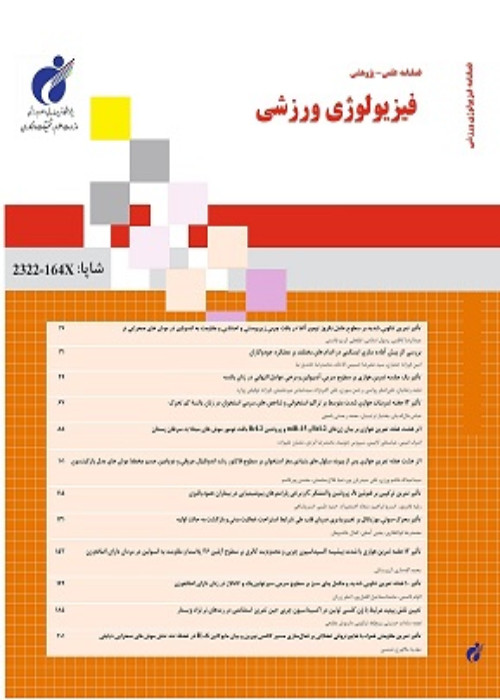Relationship between changes of appetite score with circulating levels of leptin and acylated ghrelin following a period of strength training in obese men
Author(s):
Abstract:
Abstract Introduction &
Purpose
Quality of relationship between exercise and appetite is important both for people interested in maintaining a healthy body weight and for athletes wishing to optimize performance. The purpose of this study was to survey relationship between changes of appetite score with circulating levels of leptin and acylated ghrelin following a period of strength training. Materials and Methods
In a semi-experimental study, twenty one obese young men were randomly placed at two groups: strength training (n=10, 26.7 ± 3.3 yr, 96.1 ± 5.5 kg, 31.2 ± 2.9 %, 32.6 ± 2.8 kg/m2) and control (n=11, 28.1 ± 3.7 yr, 95.7 ± 5.7 kg, 30.9 ± 3.2 %, 32.1 ± 3.7 kg/m2). General characteristics of subjects, circulating levels of leptin and acylated ghrelin (using ELISA kits), and appetite score (using Council on Nutrition Appetite Questionnaire) were assessed before and after training. Strength training protocol consisted of twelve weeks weight training (3 sessions per week, 10 stations, 3 sets 8-12 repetitions in each station, intensity 60-80% of one repetition maximum, rest between sets 1 min and between stations 2 min, duration of main training 20-40 min per each session). Data analyzed by SPSS16 software. Statistical significance was accepted at P<0.05. Results
Strength training decreased serum leptin concentration (8.0±4.1 vs. 6.1±3.6 ng/ml) and increased plasma acylated ghrelin concentration (15.1±4.6 vs. 18.6±2.8 pg/ml) and appetite score (30.4±1.7 vs. 32.3±2.2) (p=0.025, p=0.039, p=0.042 respectively). Also, changes of appetite score in strength training group were inversely correlated to serum leptin concentration changes (p=0.003), but were directly correlated to changes of plasma acylated ghrelin concentration (p=0.013, p=0.022 respectively). Conclusion
Performing strength training for twelve weeks decreases serum leptin levels, but increases plasma acylated ghrelin concentrations. These changes are associated with appetite improvement. Also, it appears that changes of appetite score following training have correlations to changes of leptin and acylated ghrelin levels (inversely and directly, respectively).Language:
Persian
Published:
Sport Physiology, Volume:4 Issue: 16, 2012
Page:
135
magiran.com/p1142088
دانلود و مطالعه متن این مقاله با یکی از روشهای زیر امکان پذیر است:
اشتراک شخصی
با عضویت و پرداخت آنلاین حق اشتراک یکساله به مبلغ 1,390,000ريال میتوانید 70 عنوان مطلب دانلود کنید!
اشتراک سازمانی
به کتابخانه دانشگاه یا محل کار خود پیشنهاد کنید تا اشتراک سازمانی این پایگاه را برای دسترسی نامحدود همه کاربران به متن مطالب تهیه نمایند!
توجه!
- حق عضویت دریافتی صرف حمایت از نشریات عضو و نگهداری، تکمیل و توسعه مگیران میشود.
- پرداخت حق اشتراک و دانلود مقالات اجازه بازنشر آن در سایر رسانههای چاپی و دیجیتال را به کاربر نمیدهد.
In order to view content subscription is required
Personal subscription
Subscribe magiran.com for 70 € euros via PayPal and download 70 articles during a year.
Organization subscription
Please contact us to subscribe your university or library for unlimited access!


